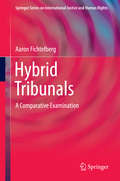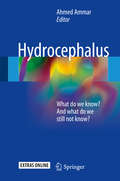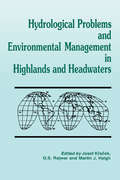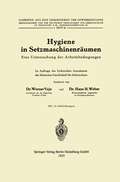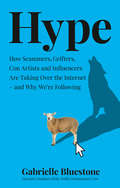- Table View
- List View
Hybrid Financial Instruments in International Tax Law
by Jakob BundgaardFinancial innovation allows companies and other entities that wish to raise capital to choose from a myriad of possible instruments that can be tailored to meet the specific business needs of the issuer and investor. However, such instruments put increasing pressure on a question that is fundamental to the tax and financial systems of a country – the distinction between debt and equity. Focusing on hybrid financial instruments (HFIs) – which lie somewhere along the debt-equity continuum, but where exactly depends on the terms of the instrument as well as on applicable laws – this book analyses their treatment under both domestic law and tax treaties. Key jurisdictions, including the EU, some of its Member States, and the United States, are covered. Advocating for a broader scope of application of HFIs as part of the financing of companies in Europe alongside traditional sources of debt and equity financing, the book addresses such issues and topics as the following: • problems associated with the debt-equity distinction in international tax law; • cross-border tax arbitrage and linking rules; • drivers behind the use and design of HFIs; • tax law impact of perpetual and super maturity debt instruments, profit participating loans, convertible bonds, mandatory convertible bonds, contingent convertibles, preference shares and warrant loans on HFIs; • financial accounting treatment; • administrative guidance; • influence of the TFEU on Member States’ approaches to classification of HFIs; • interpretation of the Parent-Subsidiary Directive by the European Court of Justice; • applicability of the OECD Model Tax Convention; and • implications of the OECD Base Erosion and Profit Shifting (BEPS) project. Throughout this book, the analysis draws upon preparatory works, case law, and legal theory in English, German, and the Scandinavian languages. In conclusion, the author considers tax policy issues, and identifies and outlines possible high-level solutions. Actual or potential users of HFIs will greatly appreciate the clarity and insight offered here into the capacity and tax implications of HFIs. The book not only examines whether existing legislation is sufficient to handle the issues raised by international HFIs, but also provides an in-depth analysis of the interaction between corporate financing and tax law in the light of today’s financial innovation. Corporate executives and their counsel will find it indispensable in the international taxation landscape that is currently coming into view, and academics and policymakers will hugely augment their understanding of a complex and constantly changing area of tax law.
Hybrid Forms of Governance: Self-suspension of Power
by Niels �kerstr�m Andersen and Inger-Johanne SandThis book is about how power communication inrecent years hasbegun to reflect on its own limits in a new way. It focuseson a number of areas within the welfare state and how power desires non-power. It looks at financial policy, voluntary policy, educational policy and public steering technologies.
Hybrid Governance in European Cities: Neighbourhood, Migration and Democracy (Understanding Governance)
by C. Skelcher Helen Sullivan S. JeffaresThis wide-ranging study of three European cities shows how hybrid forms of governance emerge from the tensions between new ideas and past legacies, and existing institutional arrangements and powerful decision makers. Using detailed studies of migration and neighborhood policy, as well as a novel Q methodology analysis of public administrators.
Hybrid Organizations: New Business Models for Environmental Leadership
by Andrew J. Hoffman Brewster Boyd Nina Henning Emily Reyna Daniel Wang Matthew WelchThis book offers a glimpse into the future. The companies it describes are pioneers, the first-movers in market shifts that will eventually become mainstream. These "hybrid organizations" – or what others call "values-driven" or "mission-driven" organizations – operate in the blurry space between the for-profit and non-profit worlds. They are redefining their supply chains, their sources of capital, their very purpose for being; and in the process they are changing the market for others. Using a combination of high-level survey analysis and, more importantly, in-depth executive interviews, the book helps fill the present gap in literature on environmentally focused and financially driven for-profit businesses. Moreover, it highlights key trends and critical themes that enable this new wave of socially conscious and fiscally minded enterprises to be successful in meeting both sets of goals. The takeaway for readers of this book is not only an appreciation for common business practices that hybrid organizations adopt, but also an understanding of the complexity of the integration of such adoption that allows them to successfully achieve both mission- and market-driven goals. The book begins with key definitions to establish the scope of this new sector, including explicit definitions for hybrid organizations, environmental sustainability missions, as well as specific criteria to create useful boundaries for the field of hybrid organizations. Building on prior work conducted by researchers on corporate social responsibility, sustainable entrepreneurship, and social enterprise, the book catalogues the best practices within this growing sector, helping others to learn from both the successes and failures of those that are choosing this strategy. The core of the book is built on an analysis of survey data from 47 hybrid organizations, investigating their business models and strategies, finances, organizational structures, processes, metrics, and innovations. The organizations represent a cross-section of size, age, industry, and geography, although the sample set is biased towards young, small, U.S.-based hybrids. Based on analysis of the survey data, five best-in-class companies were selected for in-depth case studies in order to provide instructive lessons for hybrid practitioners and researchers alike. In short, this book presents research that shows hybrid organizations to be a practical and feasible organizational model for contributing solutions to global environmental issues. The lessons in this book will help other social entrepreneurs, business managers, non-profit leaders, or students interested in careers that fuse profitability and responsibility do it even better.
Hybrid Organizations: New Business Models for Environmental Leadership
by Andrew J. Hoffman Brewster Boyd Nina Henning Emily Reyna Daniel Wang Matthew WelchThis book offers a glimpse into the future. The companies it describes are pioneers, the first-movers in market shifts that will eventually become mainstream. These "hybrid organizations" – or what others call "values-driven" or "mission-driven" organizations – operate in the blurry space between the for-profit and non-profit worlds. They are redefining their supply chains, their sources of capital, their very purpose for being; and in the process they are changing the market for others. Using a combination of high-level survey analysis and, more importantly, in-depth executive interviews, the book helps fill the present gap in literature on environmentally focused and financially driven for-profit businesses. Moreover, it highlights key trends and critical themes that enable this new wave of socially conscious and fiscally minded enterprises to be successful in meeting both sets of goals. The takeaway for readers of this book is not only an appreciation for common business practices that hybrid organizations adopt, but also an understanding of the complexity of the integration of such adoption that allows them to successfully achieve both mission- and market-driven goals. The book begins with key definitions to establish the scope of this new sector, including explicit definitions for hybrid organizations, environmental sustainability missions, as well as specific criteria to create useful boundaries for the field of hybrid organizations. Building on prior work conducted by researchers on corporate social responsibility, sustainable entrepreneurship, and social enterprise, the book catalogues the best practices within this growing sector, helping others to learn from both the successes and failures of those that are choosing this strategy. The core of the book is built on an analysis of survey data from 47 hybrid organizations, investigating their business models and strategies, finances, organizational structures, processes, metrics, and innovations. The organizations represent a cross-section of size, age, industry, and geography, although the sample set is biased towards young, small, U.S.-based hybrids. Based on analysis of the survey data, five best-in-class companies were selected for in-depth case studies in order to provide instructive lessons for hybrid practitioners and researchers alike. In short, this book presents research that shows hybrid organizations to be a practical and feasible organizational model for contributing solutions to global environmental issues. The lessons in this book will help other social entrepreneurs, business managers, non-profit leaders, or students interested in careers that fuse profitability and responsibility do it even better.
Hybrid Societies: Living with Social Robots (Routledge Studies in Contemporary Philosophy)
by Piercosma BiscontiThis book explores how social robots and synthetic social agents will change our social systems and intersubjective relationships. It is obvious that technology influences societies. But how, and under what conditions do these changes occur? This book provides a theoretical foundation for the social implications of artificial intelligence (AI) and robotics. It starts from philosophy of technology, with a focus on social robotics, to systematically explore the concept of socio- technical change. It addresses two main questions: To what extent will social robots modify our social systems? And how will human relationality be affected by human–robot interactions? The book employs resources from continental philosophy, actor–network theory, psychoanalysis, systemic theory, and constructivist cognitive theory to develop a theory of socio-technical change. It also offers a novel perspective on how we should evaluate the effectiveness of social robots, which has significant implications for how social robotics should be researched and designed. Hybrid Societies will appeal to scholars and advanced students working in philosophy of technology, AI ethics, robot ethics, and continental philosophy.
Hybrid Societies: Living with Social Robots (Routledge Studies in Contemporary Philosophy)
by Piercosma BiscontiThis book explores how social robots and synthetic social agents will change our social systems and intersubjective relationships. It is obvious that technology influences societies. But how, and under what conditions do these changes occur? This book provides a theoretical foundation for the social implications of artificial intelligence (AI) and robotics. It starts from philosophy of technology, with a focus on social robotics, to systematically explore the concept of socio- technical change. It addresses two main questions: To what extent will social robots modify our social systems? And how will human relationality be affected by human–robot interactions? The book employs resources from continental philosophy, actor–network theory, psychoanalysis, systemic theory, and constructivist cognitive theory to develop a theory of socio-technical change. It also offers a novel perspective on how we should evaluate the effectiveness of social robots, which has significant implications for how social robotics should be researched and designed. Hybrid Societies will appeal to scholars and advanced students working in philosophy of technology, AI ethics, robot ethics, and continental philosophy.
Hybrid Threats and Grey Zone Conflict: The Challenge to Liberal Democracies (Ethics, National Security, and the Rule of Law)
by Mitt Regan, Aurel SariIn the current geopolitical environment, liberal democracies vie for influence and prosperity with autocratic governments, such as those of China and Russia. While the great powers do not shy away from using aggressive force, much of their rivalry today takes place below the threshold of armed conflict, in a conceptual and practical 'grey zone' between war and peace. Autocratic states operate in this grey zone to target the vulnerabilities of liberal democracies, creating hybrid threats that rely on instruments ranging from economic, diplomatic, legal, and informational pressure all the way to military coercion. Law plays a critical role in this context. In the ethically and legally ambiguous grey zone, international law serves as a normative, yet malleable, framework within which geopolitical rivals compete. State and non-State actors invoke the law as the source of authority, while simultaneously hoping to shape the international legal order in their own strategic interests. Hybrid Threats and Grey Zone Conflict offers the first in-depth assessment of the legal and ethical aspects of hybrid threats and grey zone conflict. It explores the responses available to democratic nations for countering hybrid and grey zone threats whilst adhering to liberal democratic values and the rule of law. Bringing together diverse scholarly and practitioner perspectives, the volume introduces readers to the conceptual and practical difficulties arising in this area, the rich debates the topic has generated, and the challenges that countering hybrid threats and grey zone conflict poses for liberal democracies. This volume is essential reading for anyone interested in learning more about contemporary forms of strategic competition below the threshold of open hostilities.
Hybrid Threats and Grey Zone Conflict: The Challenge to Liberal Democracies (Ethics, National Security, and the Rule of Law)
In the current geopolitical environment, liberal democracies vie for influence and prosperity with autocratic governments, such as those of China and Russia. While the great powers do not shy away from using aggressive force, much of their rivalry today takes place below the threshold of armed conflict, in a conceptual and practical 'grey zone' between war and peace. Autocratic states operate in this grey zone to target the vulnerabilities of liberal democracies, creating hybrid threats that rely on instruments ranging from economic, diplomatic, legal, and informational pressure all the way to military coercion. Law plays a critical role in this context. In the ethically and legally ambiguous grey zone, international law serves as a normative, yet malleable, framework within which geopolitical rivals compete. State and non-State actors invoke the law as the source of authority, while simultaneously hoping to shape the international legal order in their own strategic interests. Hybrid Threats and Grey Zone Conflict offers the first in-depth assessment of the legal and ethical aspects of hybrid threats and grey zone conflict. It explores the responses available to democratic nations for countering hybrid and grey zone threats whilst adhering to liberal democratic values and the rule of law. Bringing together diverse scholarly and practitioner perspectives, the volume introduces readers to the conceptual and practical difficulties arising in this area, the rich debates the topic has generated, and the challenges that countering hybrid threats and grey zone conflict poses for liberal democracies. This volume is essential reading for anyone interested in learning more about contemporary forms of strategic competition below the threshold of open hostilities.
Hybrid Tribunals: A Comparative Examination (Springer Series on International Justice and Human Rights)
by Aaron FichtelbergThis book examines hybrid tribunals created in Sierra Leone, Kosovo, Cambodia, East Timor, and Lebanon, in terms of their origins (the political and social forces that led to their creation), the legal regimes that they used, their various institutional structures, and the challenges that they faced during their operations. Through this study, the author looks at both their successes and their shortcomings, and presents recommendations for the formation of future hybrid tribunals.Hybrid tribunals are a form of the international justice where the judicial responsibility is shared between the international community and the local state where they function. These tribunals represent an important bridge between traditional international courts like the International Criminal Court (ICC), the International Criminal Tribunal for the Former Yugoslavia (ICTY), the International Criminal Tribunal for Rwanda (ICTR) and various local justice systems. Because hybrid tribunals are developed in response to large-scale atrocities, these courts are properly considered part of the international criminal justice system. This feature gives hybrid tribunals the accountability and legitimacy often lost in local justice systems; however, by including regional courtroom procedures and personnel, they are integrated into the local justice system in a way that allows a society to deal with its criminals on its own terms, at least in part.This unique volume combines historical and legal analyses of these hybrid tribunals, placing them within a larger historical, political, and legal context. It will be of interest to researchers in Criminal Justice, International Studies, International Law, and related fields.
Hybrid Warfare under International Law
by Stuart Casey-MaslenThis book addresses the regulation of hybrid warfare under relevant branches of international law, beginning with the law on inter-state use of force (jus ad bellum).Firstly, the book assesses the extent to which forms of hybrid warfare comply with or violate international humanitarian law/the law of armed conflict. It then looks at law enforcement action in response to hybrid warfare, both on land and on the high seas, and addresses hybrid warfare from the perspective of international counterterrorism law. It goes on to tackle the constraints applied to hybrid warfare under international human rights law, and looks at how hybrid warfare could be constrained under disarmament law. The final two chapters look at accountability for the conduct of hybrid warfare, concluding with the question: can we move towards a less fragmented set of international legal rules that will govern hybrid warfare in the future?
Hybrid Warfare under International Law
by Stuart Casey-MaslenThis book addresses the regulation of hybrid warfare under relevant branches of international law, beginning with the law on inter-state use of force (jus ad bellum).Firstly, the book assesses the extent to which forms of hybrid warfare comply with or violate international humanitarian law/the law of armed conflict. It then looks at law enforcement action in response to hybrid warfare, both on land and on the high seas, and addresses hybrid warfare from the perspective of international counterterrorism law. It goes on to tackle the constraints applied to hybrid warfare under international human rights law, and looks at how hybrid warfare could be constrained under disarmament law. The final two chapters look at accountability for the conduct of hybrid warfare, concluding with the question: can we move towards a less fragmented set of international legal rules that will govern hybrid warfare in the future?
Hybridity: Law, Culture and Development (Law, Development and Globalization)
by Rosa Freedman Nicolas Lemay-HébertThis book explores recent developments in the concept of hybridity through a multi-disciplinary perspective, bringing ideas about legal plurality together with the fields of peace, development and cultural studies. Analysing the concepts of hybridity and hybridization, their history, their application in law and legal studies, and their implications for thinking and rethinking legal plurality, the book shows how the concept of hybridity can contribute to an understanding of the processes that occur when different normative or legal orders or frameworks confront each other.
Hybridity: Law, Culture and Development (Law, Development and Globalization)
by Nicolas Lemay-Hébert Rosa FreedmanThis book explores recent developments in the concept of hybridity through a multi-disciplinary perspective, bringing ideas about legal plurality together with the fields of peace, development and cultural studies. Analysing the concepts of hybridity and hybridization, their history, their application in law and legal studies, and their implications for thinking and rethinking legal plurality, the book shows how the concept of hybridity can contribute to an understanding of the processes that occur when different normative or legal orders or frameworks confront each other.
Hydrocephalus: What do we know? And what do we still not know?
by Ahmed AmmarThis book provides the reader with a well-structured, comprehensive approach to hydrocephalus and related syndromes. It also addresses the ethical dilemmas of managing hydrocephalus, of which many neurosurgeons are unaware, and presents cutting-edge research genetic and pathophysiology research on hydrocephalus. The book presents a new classification for the Dandy Walker syndrome, based on a new understanding of different hydrocephalic problems. Further, it puts forward a wholly new theory on the pathophysiology and development of multiloculated hydrocephalus. This book helps the reader to devise a long-term strategic plan to treat patients, based on research of favorable long-term outcomes of hydrocephalus. It uniquely provides evidence-based approaches to managing hydrocephalus, presenting the experience and thoughts of renowned and highly experienced neurosurgeons from the USA, Canada, Japan, Europe and the Middle East.
Hydrological Problems and Environmental Management in Highlands and Headwaters
by Martin HaighThis set of papers presents a description of the synthesis of hydrological problems and various environmental implications and management strategies for different highland and headwater regions of the world. Regions covered include the Himalayas, Russian mountains, Amazonia, and upland Wales.
Hydrological Problems and Environmental Management in Highlands and Headwaters
by Josef Křeček G. S. Rajwar Martin J. HaighThis set of papers presents a description of the synthesis of hydrological problems and various environmental implications and management strategies for different highland and headwater regions of the world. Regions covered include the Himalayas, Russian mountains, Amazonia, and upland Wales.
Hygiene in Setzmaschinenräumen: Eine Untersuchung der Arbeitsbedingungen (Schriften aus dem Gesamtgebiet der Gewerbehygiene #44)
by Werner Vaje Hans H. WeberDieser Buchtitel ist Teil des Digitalisierungsprojekts Springer Book Archives mit Publikationen, die seit den Anfängen des Verlags von 1842 erschienen sind. Der Verlag stellt mit diesem Archiv Quellen für die historische wie auch die disziplingeschichtliche Forschung zur Verfügung, die jeweils im historischen Kontext betrachtet werden müssen. Dieser Titel erschien in der Zeit vor 1945 und wird daher in seiner zeittypischen politisch-ideologischen Ausrichtung vom Verlag nicht beworben.
Hype: How Scammers, Grifters, Con Artists And Influencers Are Taking Over The Internet - And Why We're Following
by Gabrielle BluestoneFrom Vice journalist and executive producer of hit Netflix documentary Fyre comes an eye-opening look at the con artists, grifters and snake oil salesmen of the digital age—and why we can’t stop falling for them.
Hypercrime: The New Geometry of Harm
by Michael McGuireHypercrime develops a new theoretical approach toward current reformulations in criminal behaviours, in particular the phenomenon of cybercrime. Emphasizing a spatialized conception of deviance, one that clarifies the continuities between crime in the traditional, physical context and developing spaces of interaction such as a 'cyberspace', this book analyzes criminal behaviours in terms of the destructions, degradations or incursions to a hierarchy of regions that define our social world. Each chapter outlines violations to the boundaries of each of these spaces - from those defined by our bodies or our property, to the more subtle borders of the local and global spaces we inhabit. By treating cybercrime as but one instance of various possible criminal virtualities, the book develops a general theoretical framework, as equally applicable to the, as yet unrealized, technologies of criminal behaviour of the next century, as it is to those which relate to contemporary computer networks. Cybercrime is thereby conceptualized as one of a variety of geometries of harm, merely the latest of many that have extended opportunities for illicit gain in the physical world. Hypercrime offers a radical critique of the narrow conceptions of cybercrime offered by current justice systems and challenges the governing presumptions about the nature of the threat posed by it. Runner-up for the British Society of Criminology Book Prize (2008).
Hypercrime: The New Geometry of Harm
by Michael McGuireHypercrime develops a new theoretical approach toward current reformulations in criminal behaviours, in particular the phenomenon of cybercrime. Emphasizing a spatialized conception of deviance, one that clarifies the continuities between crime in the traditional, physical context and developing spaces of interaction such as a 'cyberspace', this book analyzes criminal behaviours in terms of the destructions, degradations or incursions to a hierarchy of regions that define our social world. Each chapter outlines violations to the boundaries of each of these spaces - from those defined by our bodies or our property, to the more subtle borders of the local and global spaces we inhabit. By treating cybercrime as but one instance of various possible criminal virtualities, the book develops a general theoretical framework, as equally applicable to the, as yet unrealized, technologies of criminal behaviour of the next century, as it is to those which relate to contemporary computer networks. Cybercrime is thereby conceptualized as one of a variety of geometries of harm, merely the latest of many that have extended opportunities for illicit gain in the physical world. Hypercrime offers a radical critique of the narrow conceptions of cybercrime offered by current justice systems and challenges the governing presumptions about the nature of the threat posed by it. Runner-up for the British Society of Criminology Book Prize (2008).
Hyperintensionality and Normativity
by Federico L. FaroldiPresenting the first comprehensive, in-depth study of hyperintensionality, this book equips readers with the basic tools needed to appreciate some of current and future debates in the philosophy of language, semantics, and metaphysics. After introducing and explaining the major approaches to hyperintensionality found in the literature, the book tackles its systematic connections to normativity and offers some contributions to the current debates.The book offers undergraduate and graduate students an essential introduction to the topic, while also helping professionals in related fields get up to speed on open research-level problems.
Hypocrisy and Human Rights: Resisting Accountability for Mass Atrocities
by Kate Cronin-FurmanHypocrisy and Human Rights examines what human rights pressure does when it does not work. Repressive states with absolutely no intention of complying with their human rights obligations often change course dramatically in response to international pressure. They create toothless commissions, permit but then obstruct international observers' visits, and pass showpiece legislation while simultaneously bolstering their repressive capacity. Covering debates over transitional justice in Sri Lanka, Myanmar, Cambodia, Democratic Republic of the Congo, and other countries, Kate Cronin-Furman investigates the diverse ways in which repressive states respond to calls for justice from human rights advocates, UN officials, and Western governments who add their voices to the victims of mass atrocities to demand accountability. She argues that although international pressure cannot elicit compliance in the absence of domestic motivations to comply, the complexity of the international system means that there are multiple audiences for both human rights behavior and advocacy and that pressure can produce valuable results through indirect paths.
Hypothekenrecht und Notverordnungen: Die Auswirkungen der österreichischen Notverordnungen auf das Recht der Hypothekarforderungen
by Karl TorgglerDieser Buchtitel ist Teil des Digitalisierungsprojekts Springer Book Archives mit Publikationen, die seit den Anfängen des Verlags von 1842 erschienen sind. Der Verlag stellt mit diesem Archiv Quellen für die historische wie auch die disziplingeschichtliche Forschung zur Verfügung, die jeweils im historischen Kontext betrachtet werden müssen. Dieser Titel erschien in der Zeit vor 1945 und wird daher in seiner zeittypischen politisch-ideologischen Ausrichtung vom Verlag nicht beworben.
I Am a Drug Lord: The Last Confession of a Real-Life Underworld Kingpin
by AnonymousA unique and unbelievable first-hand account of how one man fought his way to the top of the criminal underworld... and what he needed to do to stay there.As you read this, someone somewhere is buying drugs.Across the globe, millions of people are involved in the brutal, cold-blooded world of drug dealing, but only a small number make life-changing money. Only a few get to the top, make the calls, know how it all works and truly become drugs lords. And even fewer survive.I know because I am one of those drug lords.After thirty years, I've decided to retire and tell the story of how I got to the top of this tainted profession, what's involved in being a serious criminal, the tricks of the trade, the art of the deal and what it really takes to stay alive for so long.This will be my last confession. And I hope you learn something.






